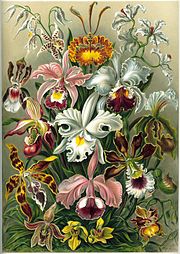Orchidaceae
From Wikipedia, the free encyclopedia
| Orchidaceae Fossil range: 80 Ma PreЄ Є O S D C P T J K Pg N ↓ | ||||||||||
|---|---|---|---|---|---|---|---|---|---|---|
 Color plate from Ernst Haeckel's Kunstformen der Natur | ||||||||||
| Scientific classification | ||||||||||
| ||||||||||
| Subfamilies | ||||||||||
|
Orchidaceae (or Orchid family) is the largest family of the flowering plants (Angiospermae).[1][2] Its name is derived from the genus Orchis.
The Royal Botanical Gardens of Kew list 880 genera and nearly 22,000 accepted species, but the exact number is unknown (perhaps as many as 25,000)[3] because of taxonomic disputes. The number of orchid species equals about four times the number of mammal species, or more than twice the number of bird species. It also encompasses about 6–11% of all seed plants.[4] About 800 new orchid species are added each year. The largest genera are Bulbophyllum (2,000 species), Epidendrum (1,500 species), Dendrobium (1,400 species) and Pleurothallis (1,000 species). The family also includes the Vanilla (the genus of the vanilla plant), Orchis (type genus) and many commonly cultivated plants like some Phalaenopsis or Cattleya.
Moreover, since the introduction of tropical species in the 19th century, horticulturists have more than 100,000 hybrids and cultivars.
Contents[hide]
|
[edit] Distribution
Orchidaceae are cosmopolitan, occurring in almost every habitat apart from deserts and glaciers. The great majority are to be found in the tropics, mostly Asia, South America and Central America. They are found above the Arctic Circle, in southern Patagonia and even on Macquarie Island, close to Antarctica.
The following list gives a rough overview of their distribution:
- tropical America: 250 to 270 genera
- tropical Asia: 260 to 300 genera
- tropical Africa: 230 to 270 genera
- Oceania: 50 to 70 genera
- Europe and temperate Asia: 40 to 60 genera
- North America: 20 to 25 genera
[edit] Taxonomy
This family is totally recognised, and the APG II system of 2003 places it in the order Asparagales.
The taxonomy of this family is in constant flux, as new studies continue to identify more classificatory elements.
Five subfamilies are now recognised. The cladogram has been made according to the APG system:
| |||||||||||||||||||||||||
[edit] Ecology

A majority of orchids are perennial epiphytes, which grow anchored to trees or shrubs in the tropics and subtropics. Other species are lithophytes, growing on rocks or very rocky soil, or are terrestrial. Nearly all temperate orchids are terrestrial.
Some orchids, like Neottia and Corallorhiza, lack chlorophyll and are unable to photosynthesise. Instead, these species obtain energy and nutrients by parasitising soil fungi through the formation of orchid mycorrhizas. The fungi involved include those that form ectomycorrhizas with trees and other woody plants, parasites such as Armillaria, and saprotrophs.[5] These orchids are known as myco-heterotrophs, but were formerly (incorrectly) described as saprophytes due to the belief that they gained their nutrition by breaking down organic matter. While only a few species are achlorophyllous holoparasites, all orchids are myco-heterotrophic during germination and seedling growth and even photosynthetic adult plants may continue to obtain carbon from their mycorrhizal fungi.
[edit] Description

Orchids are easily distinguished, as they share some very evident apomorphies. Among these: bilaterally symmetric (zygomorphic), many resupinate, one petal (labellum) is always highly modified, stamens and carpels are fused, and the seeds are extremely small.
[edit] Leaves
Like most monocots, orchids generally have simple leaves with parallel veins, although some Vanilloideae have a reticulate venation. They may be ovate, lanceolate, or orbiculate and very variable in size. Their characteristics are often diagnostic. They are normally alternate on the stem, often plicate, and have no stipules. Orchid leaves often have siliceous bodies called stegmata in the vascular bundle sheaths (not present in the Orchidoideae) and are fibrous.
The structure of the leaves corresponds to the specific habitat of the plant. Species that typically bask in sunlight, or grow on sites which can be occasionally very dry, have thick, leathery leaves and the laminas are covered by a waxy cuticle to retain their necessary water supply. Shade species, on the other hand, have long, thin leaves.
The leaves of most orchids are perennial, that is they live for several years, while others, especially those with plicate leaves, shed them annually and develop new leaves together with new pseudobulbs, as in Catasetum.
The leaves of some orchids are considered ornamental. The leaves of the Macodes sanderiana, a semiterrestrial or lithophyte, show a sparkling silver and gold veining on a light green background. The cordate leaves of Psychopsiella limminghei are light brownish green with maroon-puce markings, created by flower pigments. The attractive mottle of the leaves of Lady's Slippers from tropical and subtropical Asia, (Paphiopedilum) is caused by uneven distribution of chlorophyll. Also Phalaenopsis schilleriana is a lovely pastel pink orchid with leaves spotted dark green and light green. The Jewel Orchid (Ludisia discolor) is grown more for its colorful leaves than its fairly inconspicuous white flowers.
Some orchids, as Polyrrhiza lindenii (Ghost Orchid), Aphyllorchis and Taeniophyllum depend on their green roots for photosynthesis and lack normally developed leaves, as do all of the heterotrophic species.